How to fix LCD failure (SBIOS message) on Dell Desktop?
- JJoshua ScottSep 10, 2025
If your Dell Desktop's LCD is failing (SBIOS message), replace the LCD module.
How to fix LCD failure (SBIOS message) on Dell Desktop?
If your Dell Desktop's LCD is failing (SBIOS message), replace the LCD module.
What to do if LCD failure (EC detection of power rail failure) on Dell OptiPlex Micro 7010 Desktop?
If your Dell Desktop's LCD is failing due to EC detection of power rail failure, replace the system board.
How to resolve PCI or Video card/chip failure on Dell OptiPlex Micro 7010?
If your Dell Desktop has a PCI or Video card/chip failure, replace the system board.
What to do if power rail failure occurs on Dell Desktop?
If your Dell Desktop is experiencing a power rail failure, replace the system board.
Identifies and describes the components on the front of the computer.
Lists and describes the ports and connectors on the back of the computer.
Step-by-step instructions for connecting peripherals and powering on the computer.
Provides physical dimensions and weight specifications for the computer.
Lists supported processors and chipset details.
Details memory types, speeds, and supported configurations.
Lists and describes all available external ports on the computer.
Lists the internal slots available for expansion and storage.
Outlines the available storage options, including HDD and SSD types.
Covers integrated GPU specifications and video output capabilities.
Details hardware security features like Kensington lock and chassis intrusion.
Covers environmental factors and regulatory compliance details.
Essential safety guidelines for working on computer components.
Explains ESD risks and necessary protective measures for components.
Details safe handling, ESD packaging, and lifting equipment.
Steps to follow after completing internal work on the computer.
Lists screw types and identifies major internal components.
Step-by-step guide to remove the computer's side panel.
Step-by-step guide to install the computer's side panel.
Instructions for removing and installing the front bezel.
Detailed steps for removing and installing the hard drive.
Instructions for removing and installing M.2 SSDs.
Steps for removing and installing the wireless network card.
Procedure for removing and installing the internal speaker.
Instructions for removing and installing the system fan.
Guide to removing and installing the coin-cell battery.
Steps for removing and installing memory modules (RAM).
Procedure for removing and installing the CPU heat sink.
Instructions for installing optional I/O modules like HDMI, VGA, etc.
Procedure for removing and installing the optional Type-C module.
Steps for removing and installing the CPU.
Detailed guide for removing and installing the motherboard.
Instructions for removing and installing internal antenna modules.
Lists the operating systems supported by the computer.
Information on obtaining and installing drivers and software.
How to access the BIOS setup utility.
Details various BIOS setup configuration options.
Instructions for updating the system's BIOS firmware.
How to set, change, or delete system and setup passwords.
Guides for running hardware diagnostics and power-supply self-tests.
Explains LED codes for system status and error reporting.
Procedures for OS recovery using Dell's built-in tools.
How to reset the RTC and troubleshoot Wi-Fi connectivity.
Lists resources for product information and support.
Information on how to contact Dell technical and customer service.
| Processor Options | 12th Gen Intel Core i3, i5, i7 |
|---|---|
| Chipset | Intel Q670 |
| Weight | 2.6 lbs (1.18 kg) |
| Memory | Up to 64GB DDR5 |
| Storage Options | M.2 PCIe NVMe SSD, 2.5-inch SATA HDD/SSD |
| Graphics | Integrated Intel UHD Graphics 730/770 |
| Ports Front | 1 x Universal Audio Jack |
| Ports Rear | 1 x HDMI 2.1, 1 x DisplayPort 1.4, 4 x USB 3.2 Gen 1 Type-A, 1 x RJ-45 |
| Networking | Intel i219-LM Ethernet LAN 10/100/1000 |
| Operating System | Windows 11 Pro |
| Dimensions | 36 mm |
| Power Supply | 90 W external power adapter |
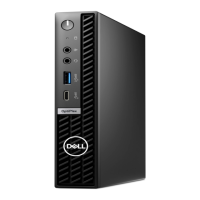


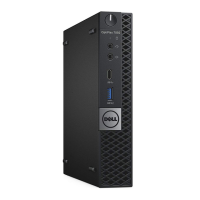
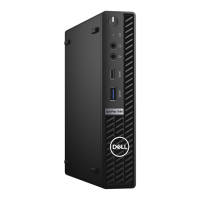

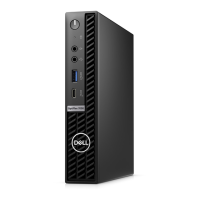
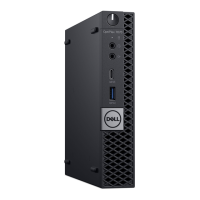
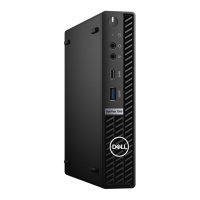
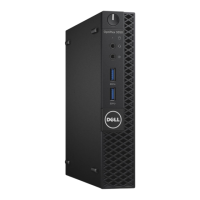

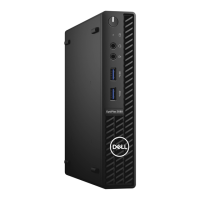
